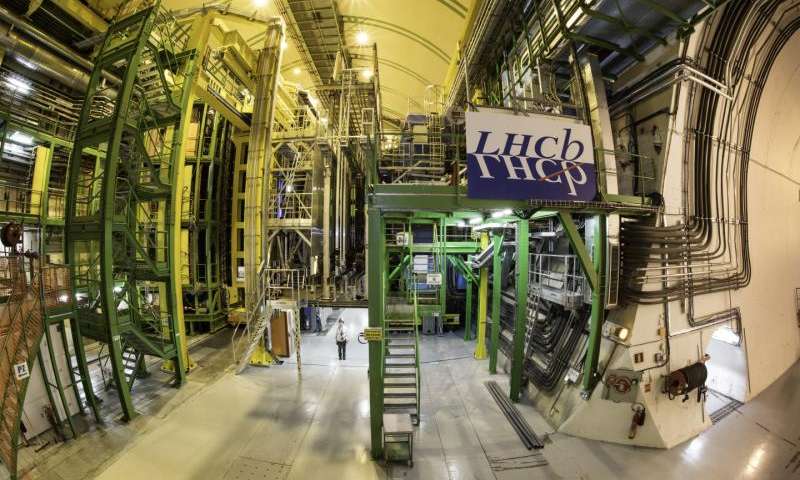
据物理学家组织网(Phys.org)2017年4月18日报道,LHCb实验发现了一些粒子衰变的有趣异常。如果这些异常得到证实,这将是粒子物理学的标准模型未曾预测到的一种新物理现象的迹象。观察到的信号仍然在统计学意义上是有限的,但从早期的研究来看强化了类似的迹象。即将到来的数据和后续分析将确定这些提示是否确实就是标准模型或统计涨落(statistical fluctuation)的瑕疵。
The LHCb experiment finds intriguing anomalies in the way some particles decay. If confirmed, these would be a sign of new physics phenomena not predicted by the Standard Model of particle physics. The observed signal is still of limited statistical significance, but strengthens similar indications from earlier studies. Forthcoming data and follow-up analyses will establish whether these hints are indeed cracks in the Standard Model or a statistical fluctuation.
Today, in a seminar at CERN, the LHCb collaboration presented new long-awaited results on a particular decay of B0 mesons produced in collisions at the Large Hadron Collider. The Standard Model of particle physics predicts the probability of the many possible decay modes of B0 mesons, and possible discrepancies with the data would signal new physics.
In this study, the LHCb collaboration looked at the decays of B0 mesons to an excited kaon and a pair of electrons or muons. The muon is 200 times heavier than the electron, but in the Standard Model its interactions are otherwise identical to those of the electron, a property known as lepton universality. Lepton universality predicts that, up to a small and calculable effect due to the mass difference, electron and muons should be produced with the same probability in this specific B0 decay. LHCb finds instead that the decays involving muons occur less often.
While potentially exciting, the discrepancy with the Standard Model occurs at the level of 2.2 to 2.5 sigma, which is not yet sufficient to draw a firm conclusion. However, the result is intriguing because a recent measurement by LHCb involving a related decay exhibited similar behaviour.
While of great interest, these hints are not enough to come to a conclusive statement. Although of a different nature, there have been many previous measurements supporting the symmetry between electrons and muons. More data and more observations of similar decays are needed in order to clarify whether these hints are just a statistical fluctuation or the first signs for new particles that would extend and complete the Standard Model of particles physics. The measurements discussed were obtained using the entire data sample of the first period of exploitation of the Large Hadron Collider (Run 1). If the new measurements indeed point to physics beyond the Standard Model, the larger data sample collected in Run 2 will be sufficient to confirm these effects.
Read more at:
https://phys.org/news/2017-04-lhcb-hints-deviations-standard.html#jCp
Today,in a seminar at CERN, the LHCb collaboration presented new long-awaited resultson a particular decay of B0 mesons produced in collisions at theLarge Hadron Collider. The Standard Model of particle physics predictsthe probability of the many possible decay modes of B0 mesons, andpossible discrepancies with the data would signal new physics.
Inthis study, the LHCb collaboration looked at the decays of B0 mesonsto an excited kaon and a pair of electrons or muons. The muon is 200 timesheavier than the electron, but in the Standard Model its interactions areotherwise identical to those of the electron, a property known as leptonuniversality. Lepton universality predicts that, up to a small and calculableeffect due to the mass difference, electron and muons should be produced withthe same probability in this specific B0 decay. LHCb finds insteadthat the decays involving muons occur less often.
Whilepotentially exciting, the discrepancy with the Standard Model occurs at thelevel of 2.2 to 2.5 sigma, which is not yet sufficient to draw a firmconclusion. However, the result is intriguing because a recent measurement byLHCb involving a related decay exhibited similar behaviour.
Whileof great interest, these hints are not enough to come to a conclusivestatement. Although of a different nature, there have been many previousmeasurements supporting the symmetry between electrons and muons. More data andmore observations of similar decays are needed in order to clarify whether thesehints are just a statistical fluctuation or the first signs for new particlesthat would extend and complete the Standard Model of particles physics. Themeasurements discussed were obtained using the entire data sample of the firstperiod of exploitation of the Large Hadron Collider (Run 1). If the newmeasurements indeed point to physicsbeyond the Standard Model, the larger data sample collected in Run 2 will besufficient to confirm these effects.
https://phys.org/news/2017-04-lhcb-hints-deviations-standard.html
